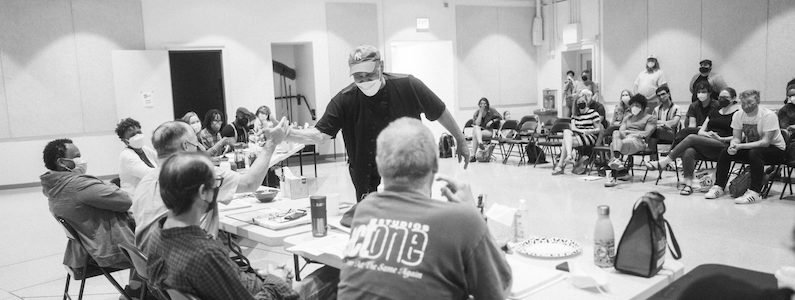In Conversation: Director Ron OJ Parson, Celeste Williams, and TayLar

Associate Director of Marketing Camille Oswald sat down with Director Ron OJ Parson and the Brewster sisters—TayLar and Celeste Williams—to find out what they love about the classic comedy Arsenic and Old Lace.
What attracted you to Arsenic and Old Lace?
Ron: Arsenic and Old Lace is a classic! I knew about it as a movie, before I knew of it as a play. A lot of times, when I’m watching old classic movies, I’ll look at the credits to check if it says, “Based on this play” or “Adapted from this play” and I’ve been doing that since I was a kid. I have a stack of old, classic movies that are based on plays that I want to do! So, I’ve been familiar with the play for a long time through the movie, and I’ve always felt that it’d be fun. Coming off of the pandemic, I knew I wanted to do something funny – I want people to laugh, and I want to laugh. I think that was at the crux of it.
I also wanted to show that, in this period, there were Black people. I didn’t want this to be just colorblind casting where anyone was playing these roles: this is a Black family! Some people are ignorant and don’t understand that, in this period, we weren’t just slaves, butlers, maids, and this and that. We were people that had a culture that had affluence to it, and had issues, and had history. We’re not getting up there and saying that, but even just us being onstage and doing the play this way – it’s obvious. I think people need to realize that we were around in the same periods they were around.
This play is a classic and has been produced many times since its Broadway premiere. Why do audiences keep returning to this play?
Ron: It’s interesting that you say that, because I really think of this as a forgotten play. It’s a known title, but people don’t know the play – they know the movie. And that goes back to what I was saying about the credits, “Based on the Broadway play.” It’s all about going back to the source. At Court, that’s what we do all the time. Charlie [Newell] does that. He goes to the source of a production; the book, or the short story, and he takes it from there. So I think that will draw audiences – draw them to something different, draw them to source of the movie they know and love.
When I thought of doing it, I looked around and saw that it was mostly community theatres doing this production. For one thing, it has a lot of actors. Professional theatres nowadays are like, “Anything more than six characters, and we’re not doing it!” [laughs] So, we looked at doubling and tripling up roles, and we’re going to make each one of them really different. Use a beard here, make someone bald there, use accents. I think that’s part of the appeal, is the fun of all the different characters. It’ll be fun for the audience, but it’s a way for the actors to have fun, too. I hired all of these actors who don’t do a lot of comedy – we’ve got all of these serious, award-winning actors – because I don’t want to do this show with obvious comedy. These two ladies are serious! They’re serious about who they are and what they’re doing, and I think the comedy lies in the fact that, for them, this is real. They think they’re really helping these people, you know?
What do you love most about this play?

Celeste: What I love about the play is how it swings from a screwball comedy to a back-in-the-day, scary, Gothic thing, and then goes back to comedy. It does have that scariness, but it always swings back to goofiness.
Ron: Exactly. And that’s why casting was so important, because an actor’s got to be able to do all of those things. So you need someone who has the talent to do that.
TayLar: I like the irony of it, how the playwright has taken dark material and made it lighthearted by putting in laughable situations. The subject matter on its own is dramatic, it’s nothing to laugh about, but he makes it really funny. I like the plot twists and the morbid humor of it all.
Ron: Let me add something to that. When Joseph Kesselring first wrote it, it was a serious drama. He originally wrote it about a serial killer, it’s a serious –
Celeste: It’s based on a true story! It was one lady, it wasn’t sisters, but it was one lady somewhere who was doing this crazy stuff!
TayLar: In Connecticut!
What does Arsenic and Old Lace teach audiences?
Celeste: This play makes me think about family and loyalty. The two sisters have been together forever, and they’re taking care of their brother. They’re the true ride-or-die family, when you think about it.
Ron: Rather than go to the police, Mortimer’s trying to protect them. He could go to the police and say, “There’s a body in my house!” but he doesn’t. Instead, he thinks, “I can’t have my aunts go to jail.”
TayLar: Right. I think it also shows people that you can find humor in places where you never thought it existed. And I guess it’s like what Celeste was saying, that family’s always there for you. Sometimes we can go over and beyond what we should do, and we think we’re helping, but we’re actually doing more harm.
Celeste: It teaches us that we all have some secrets in the cellar, too, don’t we?
What parts of your characters really resonate with you?

TayLar: For me, what resonates is my character’s sincere, innate desire to help, to support. I’m always thinking of others, trying to make their lives better, but sometimes – with my kids – I’ll try so hard to keep them from experiencing anything bad, that I get in the way. They need to make mistakes so they can learn. These women, these sisters, they’re earnest in their intent to help – donating to charities, doing wellbeing checks – but their perspective gets a little twisted, so they end up doing more harm than good. In that roundabout way, I can see us having similarities. But I don’t kill people! [laughs]
What do you want audiences to take away from this production?
Celeste: I want the audience to leave the theatre having experienced a couple hours of giggling, of laughing. I want them to have a little lightness.
TayLar: I want them to die laughing!
Ron: I want people, young and old, to be able to experience something different. I want people to be re-introduced to this play, and I want to show that people of color can do these things. It adds another element to it. It adds another layer.
If you had to be either arsenic or old lace, which would you be and why?
Ron: That’s interesting…I don’t know how to –
Celeste: That’s like one of those old Barbara Walters questions! To me, lace suggests something delicate, and I don’t think that’s me, but I’ll take it over being poison!
TayLar: I think I’d be a combination of both. As far as arsenic, I’m cool until you get on my wrong side, and then you’ve got to watch out; there’s a little something poisonous in me. So I’m delicate, but, if you take me to a certain level, we’ve got an issue.
Ron: It’s the same with the play. It’s funny until it’s not. Life right now – it’s insane. It’s a hard time to be doing any play, much less a comedy about killing people. That’s why we have to have fun with it and make people laugh. Talkbacks are probably going to be really interesting. [laughs] But I think everyone needs to laugh sometimes – laughing at ourselves can be therapeutic.

Joseph Kesselring’s Arsenic and Old Lace is on stage at Court Theatre from September 2 – October 2, 2022 → Get Tickets.